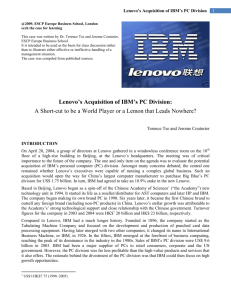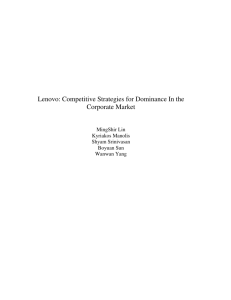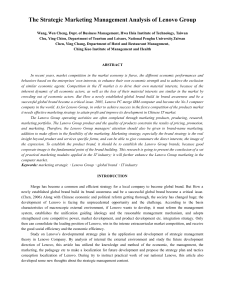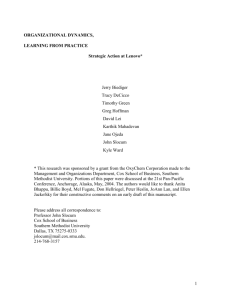Marketing 420: Global Marketing
advertisement
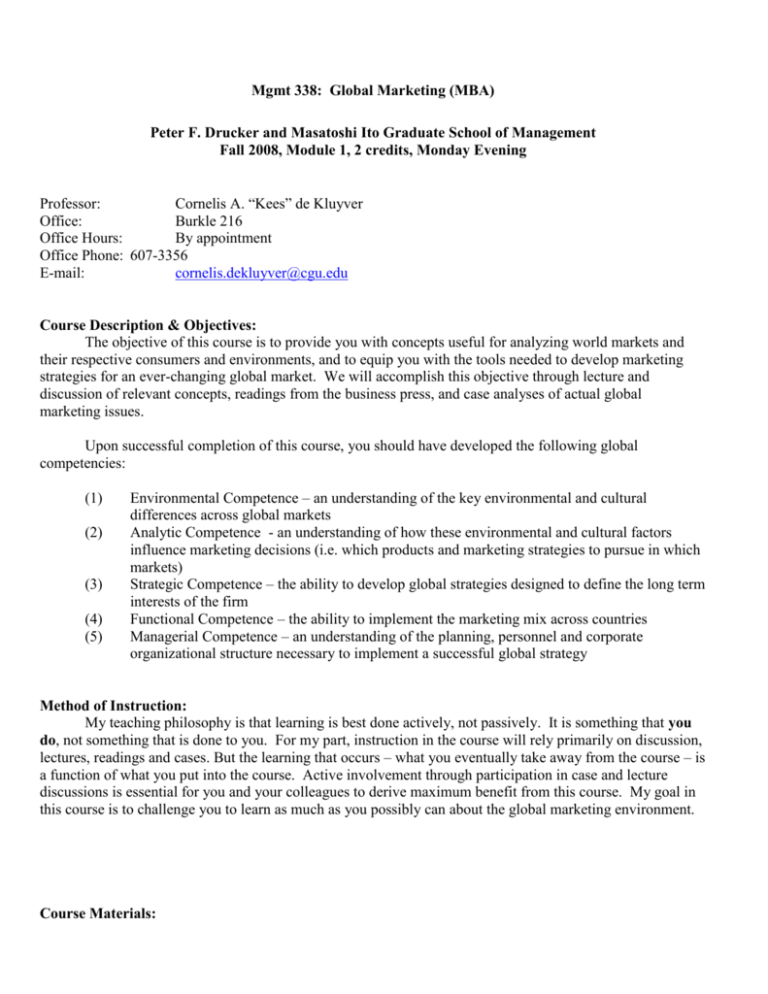
Mgmt 338: Global Marketing (MBA) Peter F. Drucker and Masatoshi Ito Graduate School of Management Fall 2008, Module 1, 2 credits, Monday Evening Professor: Cornelis A. “Kees” de Kluyver Office: Burkle 216 Office Hours: By appointment Office Phone: 607-3356 E-mail: cornelis.dekluyver@cgu.edu Course Description & Objectives: The objective of this course is to provide you with concepts useful for analyzing world markets and their respective consumers and environments, and to equip you with the tools needed to develop marketing strategies for an ever-changing global market. We will accomplish this objective through lecture and discussion of relevant concepts, readings from the business press, and case analyses of actual global marketing issues. Upon successful completion of this course, you should have developed the following global competencies: (1) (2) (3) (4) (5) Environmental Competence – an understanding of the key environmental and cultural differences across global markets Analytic Competence - an understanding of how these environmental and cultural factors influence marketing decisions (i.e. which products and marketing strategies to pursue in which markets) Strategic Competence – the ability to develop global strategies designed to define the long term interests of the firm Functional Competence – the ability to implement the marketing mix across countries Managerial Competence – an understanding of the planning, personnel and corporate organizational structure necessary to implement a successful global strategy Method of Instruction: My teaching philosophy is that learning is best done actively, not passively. It is something that you do, not something that is done to you. For my part, instruction in the course will rely primarily on discussion, lectures, readings and cases. But the learning that occurs – what you eventually take away from the course – is a function of what you put into the course. Active involvement through participation in case and lecture discussions is essential for you and your colleagues to derive maximum benefit from this course. My goal in this course is to challenge you to learn as much as you possibly can about the global marketing environment. Course Materials: (1) Text: The Global Market: Developing a Strategy to Manage Across Borders, John A. Quelch (Editor), Rohit Deshpande (Editor), ISBN: 978-0-7879-6857-1, Hardcover, 432 pages, May 2004, Jossey-Bass (2) Course packet of cases (available from the bookstore) Course Requirements/Grading Grades will be determined by the following criteria. (1) (2) (3) Class Participation 1 Case Write-Up (3 pages each max., Dbl. space, 12 pt font) Final Exam (case) 40% 25% 35% Class Participation: 1. Preparation and participation are critical to your success in the course. You will be graded on the quality (not necessarily quantity) of your contribution. 2. Preparation: My expectation is that you will come to the class having read the assigned background reading(s) and already thought through and analyzed the case study. This way, we can devote the bulk of the class time to thinking about and responding to each other's analyses of the cases and only the necessary minimum to getting the facts out. 3. Absences: As a matter of courtesy, if you are unable to attend, you must email or phone me before class. If you miss more than one class, you will be marked as absent for the entire course (NO EXCEPTIONS) 4. Classroom etiquette: Please arrive on time to class. When in class, mobile phones and pagers must be switched off. The use of laptops is permitted for note taking but discouraged for checking emails and surfing the Internet as you are expected to remain attentive and contribute to class discussion. 5. Class participation: I encourage active student participation in class and take class participation into account in determining course grades. If you are inadequately prepared to lead off the discussion of a particular reading or case, you may: (1) ask before class not to be called on, (2) pass when you are called, (3) "wing it.", or (4) faint. These actions are listed in decreasing order of attractiveness. 6. The Instructor’s role: My role in the class is to facilitate discussion. In part, I serve as a clarifier and sometimes an intensive questioner in order to help you present and develop your ideas. One of my primary roles is to manage the class process and to assure that we collectively reach a clear understanding of the issue at hand. 7. Cases: Clearly, there is no single correct solution to most cases. There are, however, wrong solutions and many lessons to be learned. There also is such a thing as weak analysis. Finally, there are solutions and analyses which are ineffective because they are not presented in an orderly and persuasive fashion. We should work together to see to it that each class session is a lively, stimulating, and intellectually rewarding venture in group learning. We are individually and collectively responsible for achieving that end. 8. Approaching a case: Each case stands on its own. Generally, I am not concerned with what was the actual outcome of the case. Such an approach would imply that there is a "right answer". The actual outcome of a situation may or may not reflect a good solution. In those instances where there was a particularly interesting outcome, it will be shared with the class. 2 Case Write-up: You are required to hand in one three-page case write-up during the course (You choose which case). Cases are due at the beginning of the class period during which the case will be presented. Hard copies only are acceptable; electronic versions of analyses are not. Absolutely no late cases will be accepted for any reason. Your write-up will be graded on the quality of your analysis and of your recommendations. Questions to be considered when writing up each case are provided at the end of this syllabus. Formatting requirements: 3 pages maximum, double spaced, 12 point font Academic Honesty You should be familiar with the University policy regarding academic honesty. The policy can be found at http://www.cgu.edu/handbook/Academic%20Honesty.doc. You should also consult the Writing Center’s guidelines as to what constitutes plagiarism (http://writecenter.cgu.edu/students/plagiarism.html). I do not tolerate academic dishonesty and will actively monitor students’ work to ensure dishonesty does not occur. A student who violates the University policy on academic honesty will get a minimum of zero for the piece of assessment for which dishonesty is established and I will ask the MBA Director to put a note on that student’s file. Late assignments and extensions Not accepted/applicable. Grading I give only a few A’s and A+’s. The course average is typically in the B-B+ range. If you perform below expectation, I give grades of C and below. My standards: A) For written work and final course grades A+ Truly exceptional performance, rarely given. A Performance significantly above expected levels. A- Performance moderately above expected levels. B+ Expected level of performance. B Performance moderately below the expected level. B- Performance significantly below the expected level. C+ Passing but marginally acceptable performance. C Unacceptably poor performance. 3 C- Very poor performance. B) For Class Participation A and A- Comes to class prepared. Contributes readily to the conversation but does not dominate it. Makes thoughtful contributions that advance the conversation. Shows interest in and respect for others’ points of view. Participates actively in small groups. Makes a genuine effort to assist colleague presenters by being engaged and involved in presentations. B+ and B Comes to class prepared and makes thoughtful comments when called upon. Contributes occasionally without prompting. Shows interest in and respect for others’ points of views. Participates actively in small groups. B- and C+ Participates in discussion but in a problematic way. Such students may talk too much, make rambling or tangential contributions, bluff there way unprepared or otherwise dominate discussions, not acknowledging cues of annoyance from other students or the professor. C and C- F Comes to class prepared but does not voluntarily contribute to discussions and gives only minimal answers when called upon. However, does show interest in the discussion, listens attentively and takes notes. Seems on the margin in class and may have a negative impact on the participation of others. Often does not participate because has not read the material in advance. May be disruptive or radiate negative energy via hostile or bored body language. May be overtly rude. 4 Global Marketing Course COURSE SCHEDULE Session Topic Assignment 1 Course Introduction: What is Global Marketing? 2 Analyzing Global Market Opportunities Book: Introduction and Part I (Ch 1-3) Reading: International Marketing Research: A Global Project Management Perspective Book: Part II (Ch 4-5) Case: L’Oréal and the Globalization of American Beauty 3 Generic Global Marketing Strategies Book: Part III (Ch 6-7) Case: BRL Hardy: Globalizing an Australian Wine Company 4 The Global Marketing Mix 1 (Product) Book: Part IV (Ch 8-9) Case: Dr. Ing. h.c. F. Porsche AG (A) and (B) 5 The Global Marketing Mix 2 (Positioning, Branding, Advertising and Promotion The Global Marketing Mix 3 (Distribution and Pricing) Book: Part V (Ch 10-11) Case: Lenovo: Building A Global Brand Organizing Global Marketing Activity Book: Part VII (Ch 14-15) Case: Samsung Electronics Company: Global Marketing Operations 6 7 Book: Part VI (Ch 12-13) Case: Marketing Château Margaux 5 BOOK: The Global Market: Developing a Strategy to Manage Across Borders John A. Quelch (Editor), Rohit Deshpande (Editor), ISBN: 978-0-7879-6857-1, Hardcover, 432 pages, May 2004, Jossey-Bass Introduction Part One: Developing the Global Mind-Set. 1. Theodore Levitt’s “The Globalization of Markets”: An Evaluation After Two Decades (Richard S. Tedlow, Rawi Abdelal). 2. “The Globalization of Markets”: A Retrospective with Theodore Levitt (Stephen A. Greyser). 3. “The Globalization of Markets” Revisited: Japan After Twenty Years (Hirotaka Takeuchi). Part Two: Managing the Global Business. 4. Rooting Marketing Strategy in Human Universals (Luc Wathieu, Yu Liu, Gerald Zaltman). 5. Organizing Multinational Companies for Collaborative Advantage (Morten T. Hansen, Nitin Nohria). Part Three: Managing Global Products. 6. Global Standardization versus Localization: A Case Study and a Model (Pankaj Ghemawat). 7. It’s a Small World After All . . . or Is It? The State of Globalization in the Worldwide Automotive Industry (Nick Scheele). Part Four: Managing Global Brands. 8. Strategies for Managing Brand and Product in International Markets (Hans-Willi Schroiff, David J. Arnold). 9. Managing the Global Brand: A Typology of Consumer Perceptions (Douglas B. Holt, John A. Quelch, Earl L. Taylor). Part Five: Managing Global Services. 10. The Globalization of Marketing Services (Martin Sorrell). 11. Cost Economies in the Global Advertising and Marketing Services Business (Alvin J. Silk, Ernst Berndt). Part Six: Managing Global Supply and Distribution. 12. Managing Global Supply Chains (Ananth Raman, Noel Watson). 13. Globalization of Retailing (David E. Bell, Rajiv Lal, Walter Salmon). Part Seven: Setting the Global Agenda. 14. The Empire Strikes Flak: Powerful Companies and Political Backlash (Daniel Litvin). 15. Globalization and the Poor (V. Kasturi Rangan, Arthur McCaffrey). 6 R. CASES AND QUESTIONS International Marketing Research: A Global Project Management Perspective (Business Horizons (2007) 50, 113–122; www.sciencedirect.com or HBS) As organizations continue to pursue more global strategies, the need to be able to understand consumers in far away places is increasing. Marketing research is the primary mechanism through which companies understand their current, as well as potential, customers. As companies contemplate the global marketplace, they must consider how domestic market research differs when conducted in international markets. In an effort to help internal client side marketing, research managers design and implement improved international research studies. Briefly discusses the context for international market research and provides a framework for conducting international market research projects. Additionally, presents several factors that should be considered by marketers who engage in global market research studies. These factors represent the variety of challenges that must be addressed in order to conduct research across national borders. Particular attention is paid to the nuances related to primary data collection and questionnaire construction. L’Oréal and the Globalization of American Beauty (9-805-086) Examines L'Oreal's acquisition of leading U.S. cosmetics brands, including Maybelline, Redken, and Kiehl's, and their subsequent renewal and globalization. Reviews the history of L'Oreal, now the world's largest cosmetics company, from its origins in France in 1907. The company entered the United States in 1953, and from 1990, expanded rapidly with the acquisition of U.S. brands, which were renewed and then taken international. Focuses on Kiehl's--since 1851, a quirky New York luxury brand--which L'Oreal acquired in 2000 and is now expanding globally. Shows how L'Oreal developed a portfolio of U.S. and European brands that are now sold globally. Explores the corporate strategy and marketing challenges facing consumer products firms as they globalize and how acquisitions can facilitate globalization. 1. How did L’Oréal become the world’s largest beauty company? What was the role of acquisitions in this growth? 2. L’Oréal offers consumers worldwide “American” and “French” concepts of beauty. Are there any limits to the national beauty images it can globalize? 3. What are the global opportunities for Kiehl’s? What are the limits, if any? BRL Hardy: Globalizing an Australian Wine Company (HBS 9-300-018) Two new product launch decisions face Christopher Carson, managing director of BRL Hardy, Europe. Responsible for the European operations of a major Australian wine company, Carson has begun to globalize his strategy beyond selling the parent company's wines. After a difficult joint venture with a Chilean wine source, he is proposing to launch an Italian line of wines. His local team has also developed a new Australian brand that would compete directly with a parent company's global brand rollout. 1. 2. 3. 4. How do you account for BRL Hardy’s remarkable post merger success? What is the source of the tension between Stephen Davies and Christopher Carson? How effectively has Steve Millar handled their differences? Should Millar approve Carson’s proposal to launch D’istinto? Why/why not? What recommendation would you make to the organization concerning the conflicting proposals for Kelly’s Revenge and Banrock Station? What would you decide to do as Carson? As Millar? Dr. Ing. h.c. F. Porsche AG (A) and (B) (9-706-018) (9-706-019) 7 Examines one of the most important entrepreneurial decisions made in the history of Porsche, made in early 1998: to build a sport utility vehicle (SUV)--the Cayenne. After decades of relying on one or two sports car models and nearly going bankrupt and losing its independence in 1993, Porsche had to diversify its product lines. Also examines the branding implications of the internationalization of production. (A) 1. Should Porsche move into the sport-utility market? Did it have other options? What would you have recommended at this time? (A) 2. Because of the success of the Boxster, its main production plant in Stuttgart-Zuffenhausen near its headquarters worked at near capacity. Where should it locate its new plant to build new SUV? How important was it for the new model to be "made in Germany"? (A) 3. By moving into the SUV market, did Porsche remain true to its brand? What does that mean in 1998? the For the (B) case, please read the “Introduction,” “Product and Partner,” and “Family Matters,” skim the rest. (B) 1. Is the Cayenne a “real Porsche?” In what ways, do you mean it is or is not? (B) 2. Would you continue to invest in Porsche and CEO Wendelin Wiedeking after it became the largest shareholder in VW after October 2005? Lenovo: Building A Global Brand (HBS 9-507-014) Announced in December 2004, the $1.75 billion acquisition of IBM's PC division by Lenovo, China's largest PC maker, made headlines around the world. A relative upstart in the business, Lenovo acquired the division of IBM that invented the PC in 1981. While Lenovo was arguably the best-known brand in China, it was virtually unknown in the rest of the world. In 2004, over 90% of Lenovo's revenues came from China, but with this major deal, Lenovo aimed to become a global technology giant. As a new multinational with 20,000 employees operating in 138 countries, Lenovo needed a global marketing and branding strategy to extend its global reach. This meant determining what Lenovo stood for and designing products that supported that claim. In January 2006, 13 months after the deal was announced and eight months after it closed, Lenovo is preparing for the intense limelight that would come with its sponsorship of the February 2006 Turin Winter Olympics. There, it plans to introduce a Lenovo-branded product line designed from the bottom up for the small to medium enterprise space--a move considered very bold and risky by many observers. 1. 2. 3. 4. 5. Why did IBM want to sell its PC business? Why did IBM sell to Lenovo? What explains Lenovo’s success prior to the acquisition? What challenges did Lenovo face after the acquisition? How should Lenovo handle the brand management challenges associated with the acquisition? In trying to become a global brand, does Lenovo have a problem coming from China? 8 Marketing Château Margaux (9-507-033) Chateau Margaux, luxury brand or connoisseur brand? Although France is awash with unsold wine, demand has never been stronger for the very finest Bordeaux. How should Margaux sustain and grow its business? The Chateau management team is wondering if it can take more control of distribution instead of leaving it to the Bordeaux wine merchants. Also, can the Chateau build marketing and sales capabilities on its own? Who is the target market, wine connoisseurs or the newly rich? Corinne Mentzelopoulous, who took over the estate from her father in 1980, wonders whether a new lower-priced wine should be added to the portfolio. 1. 2. 3. How should Margaux sustain and grow its business? Should distribution be revised? What about the rest of the Marketing Mix? Samsung Electronics Company: Global Marketing Operations (9-504-051) Samsung's global marketing director is assessing how to build the global brand reputation of the company further and upgrade the company's worldwide brand image. 1. 2. 3. What are the ingredients of SEC’s corporate turnaround strategy? How strong is the Samsung brand? Can it pass Sony in terms of recognition/ranking? As Chief marketing officer, what are Kim’s role and responsibilities? How has he built his influence? About the Instructor Cornelis A. “Kees” de Kluyver is the Masatoshi Ito Professor of Management and former Dean at the Peter F. Drucker and Masatoshi Ito Graduate School of Management at Claremont Graduate University. His professional experience includes over thirty years in academe and management consulting. Prior to coming to Claremont Graduate University, he was Dean and Professor of Management at the School of Management at George Mason University, in Fairfax, Virginia. Earlier in his career, he was a partner with Cresap Management Consultants, a Towers Perrin Company, in the firm’s strategy and organizational effectiveness practice. In this position, he served a wide range of clients in the high technology and service industries on a range of strategy issues including the globalization of multinational operations. His academic career includes several other academic appointments; as Professor of Business Administration as the Colgate Darden Graduate School of Management at the University of Virginia; as Associate Professor of Management at the Krannert Graduate School of Management at Purdue University; and as Senior Lecturer in Operations Research at the University of Canterbury, Christchurch, New Zealand. Dr. de Kluyver’s areas of research include global strategy and corporate governance. He has published extensively in the areas of Operations Research, Marketing, and Strategic Management and his writings can be found in such journals as Management Science, the Journal of Marketing Research, the European Journal of Operational Research, the Sloan Management Review, and Long Range Planning. His third book STRATEGY: A VIEW FROM THE TOP (with John A. Pearce II, published by Prentice Hall) - is in its third edition and was translated in Spanish, Portuguese, Japanese, Korean, and Chinese. Dr. de Kluyver was a member of the first Blue Ribbon Commission on Executive Compensation convened by NASD, which focused on developing standards for stock option grants, and a senior advisor to Institutional Investor, Inc., which deals with governance issues in the Asset Management Industry. 9 Dr. de Kluyver has served on a number of corporate and philanthropic boards. He has held visiting appointments at Oxford University (U.K.) and the University of Stellenbosch (S.A.). He is a frequent speaker to professional audiences, and holds a Ph.D. in Operations Research from Case Western Reserve, an MBA for the University of Oregon and undergraduate degrees from the University of Oregon and from Nijenrode, the Netherlands School of Business. 10







